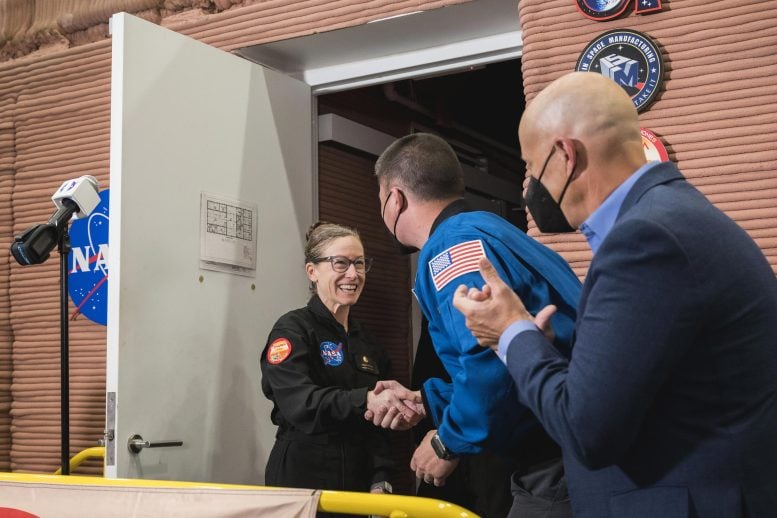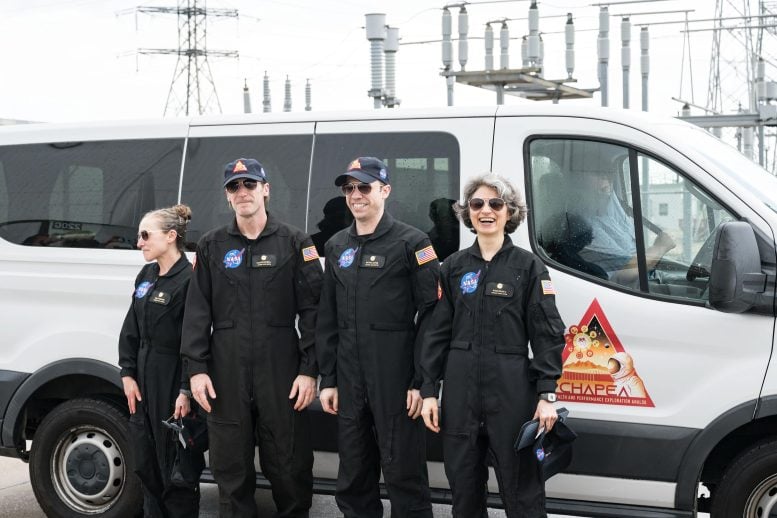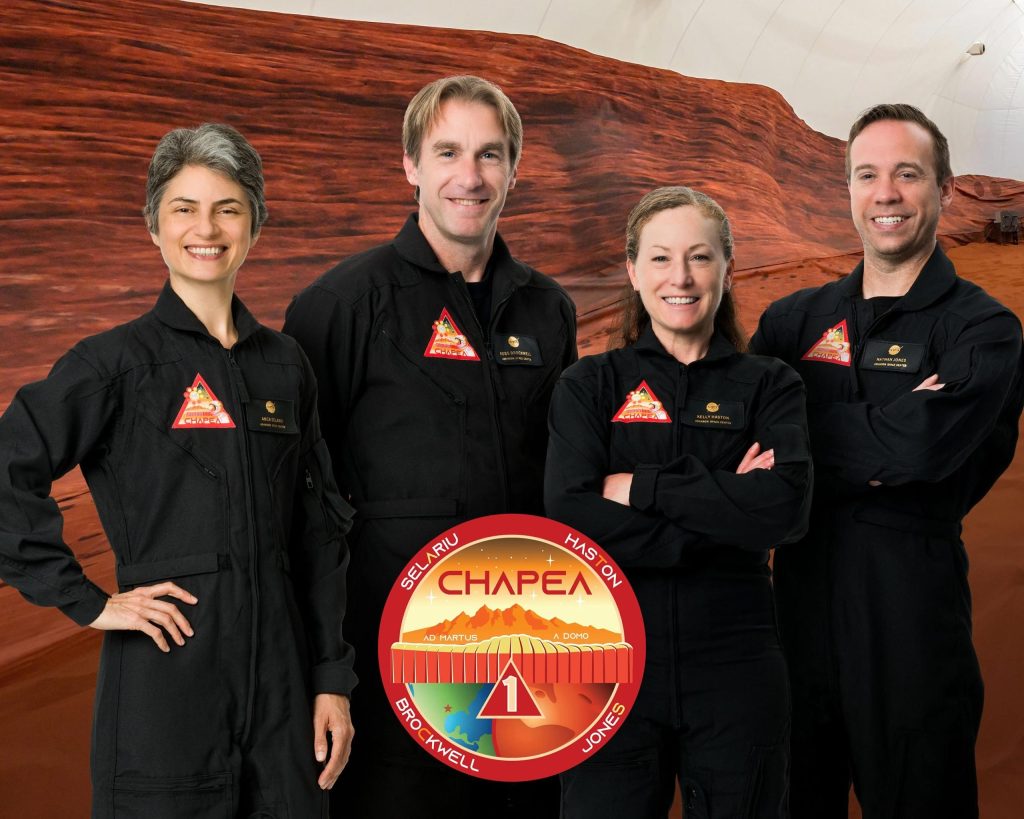The four-person crew completed a year-long Mars simulation under NASA’s CHAPEA program, testing human resilience in a 3D-printed habitat to gather data for future Mars missions, with more simulations planned. Credit: NASA
National Aeronautics and Space Administration (NASA)The first CHAPEA crew completed a year of simulations. Mars During the mission at Johnson Space Center, a four-person crew lived in 3D-printed habitats to evaluate human health and performance under isolation and confinement.
The simulation is part of NASA’s broader Artemis planning, which aims to plan additional analog missions by 2025 to expand research data and prepare for future crewed missions to Mars.
The first CHAPEA (Crew Health and Performance Exploration Analog) crew left their simulated Mars habitat at NASA’s Johnson Space Center in Houston and “returned to Earth” on July 6. CHAPEA Mission 1, the first of three simulated missions, was designed to help scientists, engineers and mission planners better understand how life on another planet might affect human health and performance.

NASA’s CHAPEA (Crew Health and Performance Exploration Analog) crew member Kelly Haston greets Kjell Lindgren, associate director for flight operations, and Steven Corner, associate director of Johnson Space Center, at the habitat entrance. Photo by NASA/Josh Valcarcel
CHAPEA Mission 1 Crew
Commander Kelly Haston, Flight Engineer Ross Brockwell, Medical Officer Nathan Jones and Science Officer Anca Serariu lived and worked in an isolated, 1,700-square-foot, 3D-printed habitat to support human health and performance research in preparation for future Mars missions.
“Congratulations to the CHAPEA 1 crew for completing their year-long stay in a simulated Mars environment,” said NASA Administrator Bill Nelson. “Through the Artemis missions, we will apply what we’ve learned on and around the Moon to take the next giant leap – sending the first astronauts to Mars. The CHAPEA mission is critical to developing the knowledge and tools humanity will need to one day live and work on the Red Planet.”
The crew will leave their habitat and return to the arms of their families and friends after a 378-day simulated Mars surface mission that began on June 25, 2023.

The CHAPEA crew ejects from a simulated Mars exploration mission at NASA’s Johnson Space Center in Houston on July 6, 2024. From left: Kelly Haston, Nathan Jones, Anka Serrariu, and Ross Brockwell. Photo by NASA/Josh Valcarcel
The rigors of Mars exploration simulation
In this high-fidelity simulation, the crew performed different types of mission objectives, including a mock “Mars walk,” robotic operations, habitat maintenance, exercise, and crop cultivation. The crew also faced intentional environmental stressors, including resource limitation, isolation, and confinement in the habitat. Over the next two weeks, volunteers will complete post-mission data collection activities before returning home.
“We planned these final 378 days with an eye toward the many challenges the crew will face on Mars, during which they have dedicated their lives to achieving this unprecedented operational goal,” said Grace Douglas, CHAPEA principal investigator. “We look forward to digging into the data we collected and preparing for CHAPEA Mission 2 and ultimately, a human presence on Mars.”

The CHAPEA crew has “returned home” after a 378-day mission inside a simulated Mars habitat. Credit: NASA /Josh Valcarcel
CHAPEA’s wider impact on space exploration
As NASA seeks to establish a long-term home base for scientific discovery and exploration on the lunar surface through its Artemis program, analog missions like CHAPEA provide scientific data to validate systems and develop technological solutions for future Mars missions.
Two more one-year CHAPEA missions are planned, with the next one scheduled to launch in 2025. Subsequent missions will be largely similar, allowing researchers to collect data from more participants to expand the dataset and provide a broader perspective on how realistic resource limitations, isolation, and confinement on Mars might affect human health and performance.
Expanding the scope of segregation research
NASA has several other avenues for collecting segregation research, including the Human Exploration Research Center, Antarctica and other analogs, and manned spaceflight missions to Earth. International Space Station This is to ensure that we achieve important research objectives that will inform future human missions to the Moon and Mars.
The CHAPEA simulation mission is unique in testing the effects of long-term isolation and confinement on Mars with realistic communication time delays with Earth (up to 44 minutes round trip) and resource limitations associated with Mars, including a more limited food system that can be supported on the space station and other similar environments.
Watch the crew exit the living quarters as they do so:
Four volunteers who have been living and working in a habitat simulating NASA’s first year-long Mars inhabited mission departed their ground home on Saturday, July 6. The first Crew Health and Performance Exploration Analog (CHAPEA) mission will launch in the 3D-printed habitat on June 25, 2023, with crew members Kelly Haston, Anka Serariu, Ross Brockwell and Nathan Jones. For over a year, the crew simulated Mars mission operations including “Mars Walks,” growing and harvesting several vegetables to supplement shelf-stable foods, maintaining their equipment and habitat, and working under the additional stressors experienced by Mars crew members, including communication delays with Earth, resource limitations and isolation. Credit: NASA Johnson
NASA’s Artemis program will see the agency establish a foundation for long-term scientific exploration on the Moon’s surface; land the first woman, the first person of color, and the first international partner astronauts on the Moon; and prepare for human exploration of Mars for the benefit of all people.


